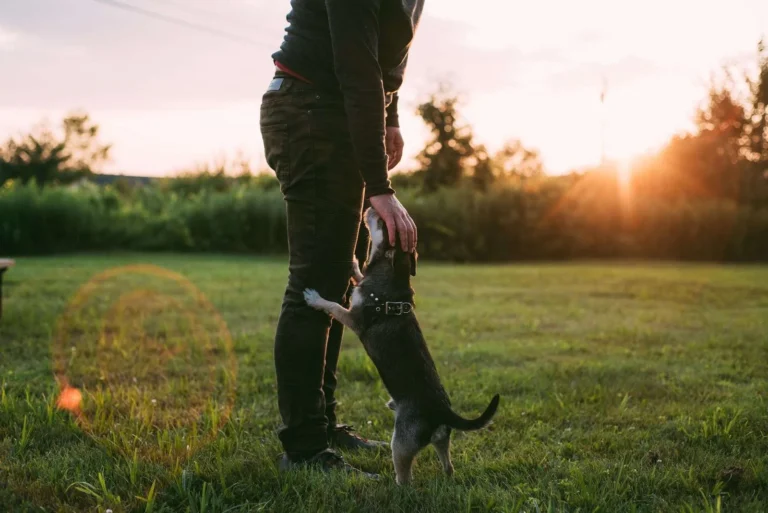Why do Dogs Wag Their Tails?
Why Dogs Wag Their Tails
To answer the question in brief – dogs wag their tails to visually communicate emotional states and social intentions. Tail wagging reflects positive moods like happiness or excitement but can also indicate negative states like anxiety or submission.
The speed and direction of the wag provides nuanced information – a fast, right-biased wag often conveys friendliness while a slow, left-biased wag suggests wariness. In short, tail wagging serves an important social signalling function for dogs by externalising their internal mindset and reactions to others.
However, as with most subjects, there is far more to learn about why dogs wag their tails, but before we have a deeper look at the subject, please allow me to give the same warning I give to everybody when it comes to dogs wagging their tails:
Just because a dog is wagging its tail doesn’t mean it is friendly!
Please don’t approach a dog you don’t know because it is wagging its tail. Unless you understand other body language that dogs display, or know the dog in question, a wagging tail is not proof of friendliness!
That being said, let’s take a look at why dogs wag their tails.
The Basics of Tail Wagging
Dogs are well-known for their tail wagging. It’s one of their most expressive behaviours. A wagging tail can mean various things, from excitement to fear, and understanding this behaviour is important to interpreting a dog’s emotions and intentions.
Tail Wagging as Communication
Fundamentally, tail wagging is a form of communication. Dogs don’t have words like we do, so they use their bodies to express themselves. When a dog wags its tail, it’s sending a message. Think of it as their way of talking.
The Emotional language of Tail Wagging
Different tail wags can mean different things:
- Happiness: This is the most common interpretation. A dog with a wagging tail often seems happy or excited. It’s their way of showing joy, like when you come home from work.
- Friendliness: When a dog wags its tail upon meeting new people or other animals, it can be a sign of friendliness, like saying, “I’m nice, let’s be friends.”
- Interest: Sometimes, when a dog is curious about something, it will wag its tail. It’s like they’re saying, “That’s interesting, tell me more.”
- Anxiety or Uncertainty: A slow wag or a wag with a low tail can indicate nervousness or uncertainty. It’s as if the dog is saying, “I’m not sure about this.”
- Aggression: Surprisingly, a tail wag can also signal aggression. A stiff, high wag can mean a dog is on alert or feeling territorial.
The Science Behind Tail Wagging
Why do dogs physically wag their tails? It’s all about biology and evolution.

- Natural Instincts: Tail wagging is an instinctive behaviour. Dogs are born with this ability, just like they’re born knowing how to bark.
- Body Language: In the animal kingdom, body language is hugely important. Tail wagging is a part of a dog’s body language toolkit, helping them communicate with other dogs and with humans.
- Social Interaction: Dogs are social creatures. Tail wagging is a way they interact with their environment, whether it’s with people, other dogs, or even other animals.
- Emotional Responses: Dogs have emotions, and tail wagging is a physical manifestation of these feelings. Just as humans smile or frown, dogs wag their tails.
The Role of Breed and Personality
Not all dogs wag their tails in the same way. Breed and personality play a role.
- Breed Differences: Some breeds are more prone to tail wagging than others. For example, Labradors are known for their enthusiastic tail wagging.
- Personality Variations: Just like people, each dog has its own personality. Some are more expressive with their tails than others.
Human Interpretation and Misinterpretation of Tail Wagging
As humans, we often interpret a dog’s tail wagging based on our own feelings. But it’s important to remember that dogs are not humans. Misinterpreting a wag can lead to misunderstandings. For instance, assuming a wagging tail always means happiness can be misleading, and can lead to accidents.
As stated at the beginning of this article – never assume a dog is friendly because it is wagging its tail!
The Tail Wagging Spectrum
Tail wagging can vary in speed, direction, and height, each adding nuances to the message:
- Speed: A fast wag is different from a slow wag.
- Direction: Some studies suggest that the direction of the wag (right or left) can indicate different emotions.
- Height: The height of the tail while wagging can also be significant.
Conclusion
If we know a dog well, it is far easier to understand what that dog is communicating via the wags of its tail, and in general – it is possible to understand what most dogs mean by watching their tails – there must be a standard language in the canine world, otherwise how would dogs communicate with one another?
However, there are always nuances – for instance, you’d be wary of a man who was smiling at you, if he was simultaneously slapping a fist into his palm and walking at speed towards you.
We can observe this additional body language in dogs. too, and its important to watch the body language of dogs we are not familiar with before we interact with them.
Thanks for reading, and we hope we answered your question!
Please take a look at some of our other articles, or visit our shop – we donate 10% of profits to UK based dog charities or shelters.






